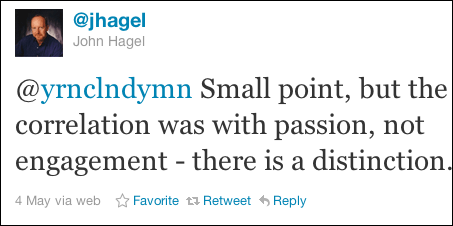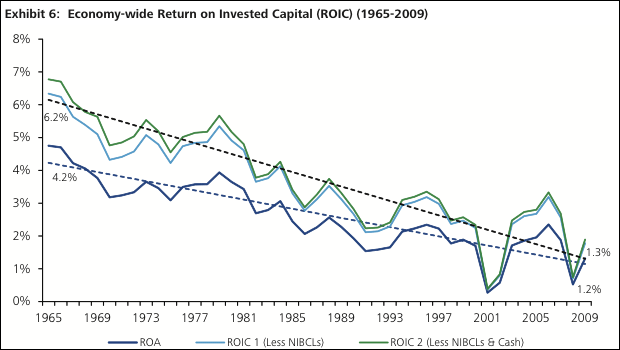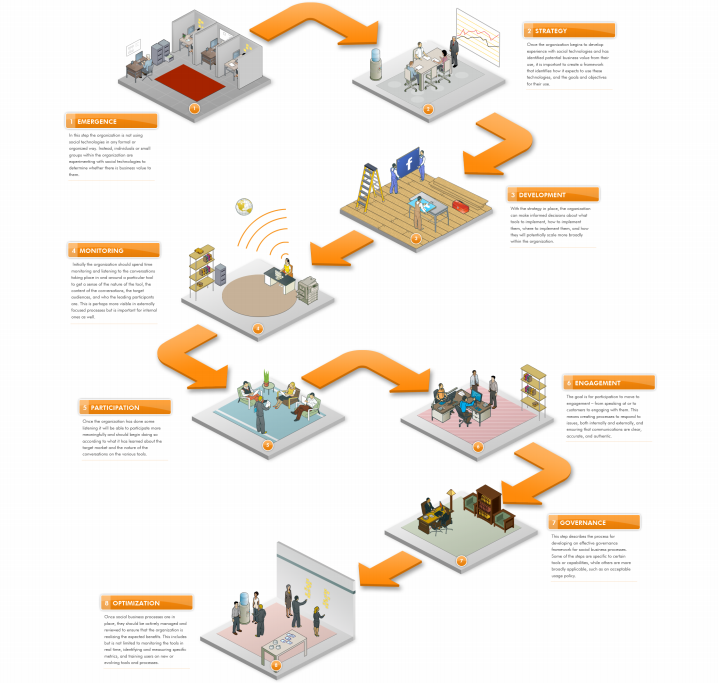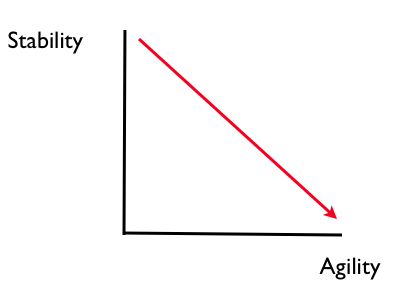A Tweet by John Hagel caught my eye last week:
John was referring to one of the findings of The Shift Index, as published by John and his team at Deloitte. What caught my eye in contrasting passion to that of engagement, is that engagement is such a buzzword and is often heralded as the key endeavour in so many different contemporary realms. For example, in both the consumer and business to business marketplace, customer engagement increasingly the aspiration of much social relationship management and the topic of many a social media marketing book and website.
However the engagement John was referring to here was not that of engaging in the social marketplace, but that of employee engagement and the need for what he defines as a new level of engagement, that of passion and thus, the passionate worker.
“Worker Passion, different from employee satisfaction, denotes an intrinsic drive to do more and excel at every aspect of one’s profession.”
The Flow Index
The passionate worker is a nuanced entity in the Index and stands also as a metric for monitoring aspects of long-standing and systemic change taking place in the US economy. Alongside social media use, the passionate worker stands as a metric for what the Index calls a ‘Flow Amplifier‘. This amplifier forms part of what the Index dubs a Flow Index, which is a broad measure of the changes brought about by a shift from Knowledge Stocks to Knowledge Flows. The other two drivers, Virtual Flows and Physical Flows define movements in connectivity and virtualisation, and the movement of capital and people.
Only 18% have passion
But measuring passion is more than just a metric, it also ups the ante in terms of the whole issue of employee engagement and opens up questions on just how engaged workers really are. Thus, while most American employees are, to use one measure of engagement, satisfied with their current company, only 18% are passionately engaged with their current employment:
“The bottom line is that nearly 80 percent of workers lack passion regarding their jobs.”
This is important for the Index, as only the passionate worker is fully engaged with their job – the satisfied worker may like and contribute to their work, but this is ultimately not enough.
Cognitive Dissonance
There is a problem here however as the Index argues that companies find it increasing difficult to keep hold of the very people vital to their long-term success. A cognitive dissonance is created between what they desire and what they experience and the passionate worker can leave to pursue other often more individualistic endeavours such as forming their own smaller company, contracting and consulting.
This, the Shift Index argues, is a big loss and of paramount importance: the stakes are not just about engagement and employee satisfaction, passionate workers the Index argues are of vital importance for the long-term well being of the American economy.
The Performance Paradox
To understand this role of the passionate worker, we need to look at the the macro-economic backdrop. The picture painted by the Index is counter-intuitive to much mainstream thinking. Most people would argue that the increases in productivity brought about the arrival of a knowledge based economy have been translated into an increase in value generated. However, in what Index dubs the ‘Performance Paradox‘ companies find it difficult to hold on to this created value, even when they’re more productive.
“…productivity is not translating into profit for companies. The old assumption that improvements in productivity lead to higher returns turns out to be flawed.”
And this it turns out, hold so even in those sectors with the biggest use of new technology: the Technology sector itself, plus Media, Telecommunications, and Automotive.
A picture of decline
The Index depicts this in graphic fashion in terms of the Return on Assets and on the Return on Invested Capital over the last 4 decades:
The real importance of the Passionate Worker
It’s against this picture of decline that the role of the passionate worker becomes so important:
“In a world driven by the twin forces of technology infrastructure and public policy shifts, the primary source of value creation for companies is moving from accumulating and exploiting “stocks” to participating in “flows” of knowledge. This activity takes place primarily through talented workers, who monetize the intangible assets that now account for the lion’s share of profits at big companies in the developed world. Since passionate workers have a greater propensity to participate in knowledge flows, it makes sense for companies to find ways to increase the amount of passion workers find in and bring to their jobs.”
The passionate worker can help achieve this turnaround this via two propensities: they have questioning and connecting dispositions. The questioning disposition means that the passionate worker sees challenges as opportunities for new ways to do things; while they will connect up with relevant others to achieve these gains. The important thing to stress here is that in an economy defined by Knowledge Flows that it’s via these traits that the passionately engaged worker brings value, new value.
“Passionate workers drive sustained extreme performance improvement. Without passionate workers, at all levels of the organization, companies will find it increasingly difficult to turn around the continued deterioration in financial performance which has thus far been a key marker of the Big Shift.”
Conclusion
I’ve only touched the surface of the Shift Index and focused on those aspects that interested me the most. It’s rich and complex with a lot of detail and well worth reading in full. A couple of closing remarks. Firstly the Index is about America, as a European I would have liked the scope to be increased – does what holds for America hold for Europe for example?
Perhaps more importantly, I would have liked to have seen a more global comparison of profitability. The real and massive shift we seeing is that of productive power and wealth and ultimately most likely political power from West to East, the symptoms of which we see played out in the form of recession. Do we therefore see the same declining rates in China as seen in the US? I think probably not. And as for the UK…well at least there’s still a substantial industrial economic base elsewhere, here, all we seem to be left with are those knowledge flows…Is this enough?
Finally, the declining rates did remind me of a tendency discovered by an obscure old German philosopher once dubbed ‘The Declining Rate of Profit‘. Is there a difference?




